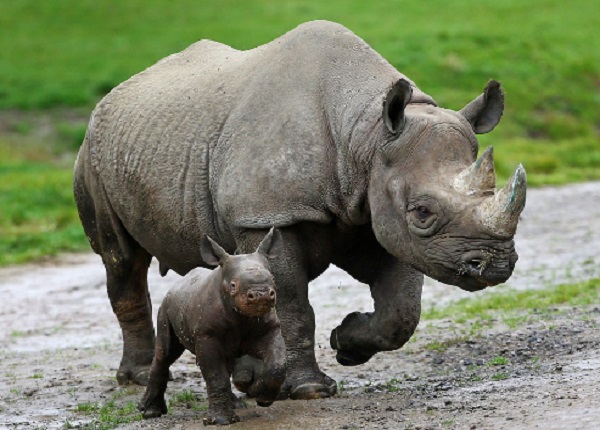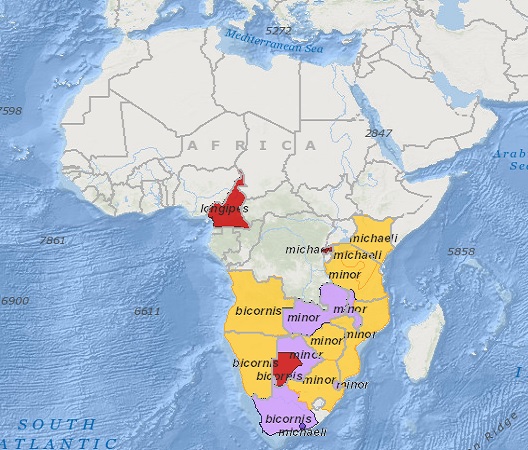Kingdom |
Phylum |
Class |
Order |
Family |
Genus |
Species |
| Animalia | Chordata | Mammalia | Perissodactyla | Rhinocerotidae | Diceros | D. bicornis |

Damara, first time mother and her calf from Howletts Wild Animal Park near Canterbury in Kent. Source: Daily Mail

o
o
Conservation
- The IUCN Red List of Threatened Species lists the Black Rhino as Critically Endangered.
- The species is listed on CITES Appendix I.
- International trade in Black Rhinos and their products is prohibited.
Fun Facts about Rhinos
- Rhinos are one of the oldest groups of animals.
- They provide important source of income from ecoturism.
- In 1961 WWF was the first organization to launch an international effort to save black rhinos from extinction.
- Their name come from two Greek words, rhino meaning nose and ceros meaning horn.
- A group of rhinos is called a crash.
Name
- Common Name: Black Rhinoceros, African Black Rhinoceros, Black Rhino.
- Scientific Name: Diceros bicornis
Distribution
- Its original distribution comprised the entire African continent south of the Sahara except for the Congo Basin. Currently the Black Rhino’s distribution is very fragmented.
- Central-West Black Rhino (Diceros bicornis longipes) – Extinct
- Southern-central Black Rhino (Diceros bicornis minor) – South Africa and to a lesser extend Zimbabwe. Small numbers remain in Tanzania.
- Southern-western Black Rhino (Diceros bicornis bicornis) – Namibia and South Africa.
- Eastern Black Rhino (Diceros bicornis michaeli) – Kenya and small numbers in Tanzania

Black Rhino distribution map. Adapted from IUCN.
Population
- The Central-West Black Rhino subspecies has been completely wiped out from earth. The Black Rhino species as a whole has seen its population decline by approximately 97.6% since 1960.
- There were 2,410 Black Rhinos in 1995. In 2010 numbers were improving with 4,880 individuals.
- As of December 2010 the estimated population of wild black rhinos were as follows: 2,200 Southern-central Black Rhinos, 1,920 South-western Black Rhinos, and 760 Eastern Black Rhinos.
- During the second half of the 20th century hunting, large scale poaching and land clearance comprised for the almost disappearance of the species.
- About 96% of the wild Black Rhinos are in South Africa, Namibia, Zimbabwe and Kenya.
Habitat
- Most rhinos live in savannas with nutrient rich soils. However they are also found in forests, tropical and subtropical.
- They usually choose to stay within 25 km from a source of water.
Physical Features
- Black Rhinos are not actually black. Their skin color fluctuates from yellow-brown to dark brown but the majority is grey. Their coloration depends on the habitat.
- The difference between black and white rhinos is that Black Rhinos have a pointed upper lip while White Rhinos have a square upper lip.
- They have two horns which grow as much as 3 inches (8 centimeters) a year. The front one is the largest one. They use them to protect themselves and their young. Females have longer and thinner horns than males.
- Their skin is hairless except for the short hair on their ears.
Size and Height
- Males are slightly larger than females.
- They measure between 55 to 71 inches (1.4 to 1.8 meters) at shoulder height.
- Their head and body length is between 9.8 to 2.5 feet (3 to 3.75 meters).
- Black Rhinos weight between 1,764 to 3,086 lb (800 to 1,400 kg).
Behavior
- These mammals are herbivores. Black Rhinos are browsers and get their nutrition from eating trees, bushes, branches and fruits, they show a preference for acacia. They eat an average of 52 lb (23.6 kg) of food a day.
- The basic social unit is the mother and her calf. Males are solitary until is time to mate. Temporary associations are sometimes formed but they do not last long.
- Black Rhinos are diurnal, they eat during the night, dawn and dusk and during the day they rest under the shade.
- They protect their skin from the sun and against bugs by rolling in mud.
- They have a strong sense of smell.
- They mark their territory by defecating and urinating on it. They show aggression if another rhino enters its territory.
- Home range varies depending on the habitat. They fluctuate from 1.62 to 82.6 sq miles (2.6 sq km to 133 sq km). A smaller home range is the result of better habitat condition in which water and food are readily available. Under poor conditions the animals have to travel longer distances to a water source and look around for food.
Reproduction
- Black Rhinos are polygynous. They breed at any time of the year but peak season varies by location. They breed every 2 to 4 years.
- Males reach sexual maturity at around 7 to 8 years, while females between 5 to 7 years.
- Gestation lasts about 15 months.
- Calfs are weaned after 18 months but they remain dependent on their mothers for up to 4 years. They have to leave when the mother has another offspring.
Life Expectancy
- In the wild Black Rhinos live between 30 to 35 years.
- In captivity they can live over 45 years.
Predators
- Lions and spotted hyenas prey on young rhinos.
- The most dangerous predator of Black Rhinos are humans.
Threats
- Black Rhinos are primarily killed for the commercial demand of their horns used in Traditional Chinese Medicine. Horns are also used in ceremonial traditions in some Middle Eastern countries.
- Civil war in African countries has had negative effect on conservation efforts, as people faced with violence trade rhino horns for machine guns to protect themselves.
- Encroachment of rhinos’ habitat as more people move into rhino lands to convert them into agricultural land.
References and Further Research
- ITIS Report – African Black Rhino
- WWF – Black Rhino
- Scientific American – How the Western Black Rhino Went Extinc
- IUCN Red List of Threatened Species – Diceros bicornis
- University of Michigan Museum of Zoology – Diceros bicornis
- Smithsonian National Museum of Natural History
- Denver Zoo – Black Rhonoceros
- WAZA World Association of Zoos and Aquariums -Black Rhinoceros
- Cites Appendix I